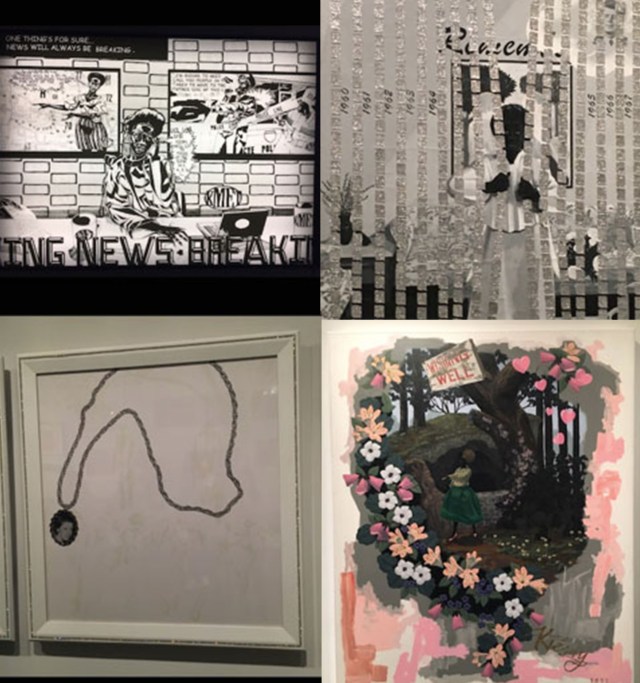by Lori Lakin Hutcherson (@lakinhutcherson)
In today’s Daily Drop, we explore the term “Afrofuturism” and its origin. To read about it and see links to sources, read on. To hear about it, press PLAY:
Audio Player[You can follow or subscribe to the Good Black News Daily Drop Podcast through Apple Podcasts, Spotify, Google Podcasts, rss.com or create your own RSS Feed. Or just check it out here on the main website. Full transcript below]:

Hey, this is Lori Lakin Hutcherson, founder and editor in chief of goodblacknews.org, here to share with you a daily drop of Good Black News for Tuesday, May 3rd, 2022, based on the “A Year of Good Black News Page-A-Day Calendar” published by Workman Publishing.
It’s in the category we call “Lemme Break It Down,” where we explore the origins and meanings of words and phrases rooted in the Black Lexicon and Black culture. Today’s word? “Afrofuturism.”
[Excerpt from “Space Is The Place” by Sun Ra]
“Afrofuturism” is a term that was coined in the 1994 essay “Black to the Future” by Mark Dery that describes a movement within Black culture from the 1950s to the present that employs science fiction and fantasy as frameworks to reimagine the African diaspora in music, art, literature, film, and fashion.
Musicians such as Sun Ra, who you are hearing right now, George Clinton, Janelle Monae, Erykah Badu; visual artists such as David Alabo, Ellen Gallagher, Kerry James Marshall, Kaylan F. Michael; and authors such as Octavia E. Butler, Samuel R. Delany, Tananarive Due and N.K. Jemisin all explore Afrofuturism in their work.
To learn more about “Afrofuturism,” read Mark Dery’s 1994 essay, available online in PDF, read Afrofuturism: The World of Black Sci-Fi and Fantasy Culture by Ytasha L. Womack, Afrofuturism 2.0: The Rise fo Astro-Blackness edited by Reynaldo Anderson and Charles E. Jones.
You can also watch the short PBS documentary called Afrofuturism 101 at pbs.org, download the This American Life “We Are The Future” podcast episode on Afrofuturism by Neil Drumming, check out the list of other Afrofuturism-themed podcasts on player.fm, and listen to the awesome “Space is The Place” Afrofuturism playlist curated by Good Black News contributor Marlon West.
Links to these sources and more are provided in today’s show notes and in the episode’s full transcript posted on goodblacknews.org.
This has been a daily drop of Good Black News, written, produced and hosted by me, Lori Lakin Hutcherson.
Intro and outro beats provided by freebeats.io and produced by White Hot.
Excerpts from Sun Ra’s “Space is the Place” are included under Fair Use.
If you like these Daily Drops, follow us on Apple, Google Podcasts, RSS.com, Amazon,Spotify or wherever you get your podcasts. Leave a rating or review, share links to your favorite episodes, or go old school and tell a friend.
For more Good Black News, check out goodblacknews.org or search and follow @goodblacknews anywhere on social.
Sources:
- https://www.wired.com/story/how-afrofuturism-can-help-the-world-mend/
- https://www.wnycstudios.org/podcasts/anxiety/episodes/black-people-are-outer-space
- https://newsroom.ucla.edu/magazine/afrofuturism
- https://www.architecturaldigest.com/story/what-is-afrofuturism
- https://www.essence.com/entertainment/a-beginners-guide-afrofuturism/
- https://www.sfjazz.org/onthecorner/we-travel-space-ways-afrofuturism-music
- https://www.npr.org/transcripts/968498810
- https://youtu.be/154XnA1xcis (short video on Afrofuturism)
- https://youtu.be/ppNai6KOXyQ (Afrofuturism in film)
- https://youtu.be/IW1eUuZaF2o (Afrofuturism TedX Masi Mbewe)
(amazon links are paid links)









